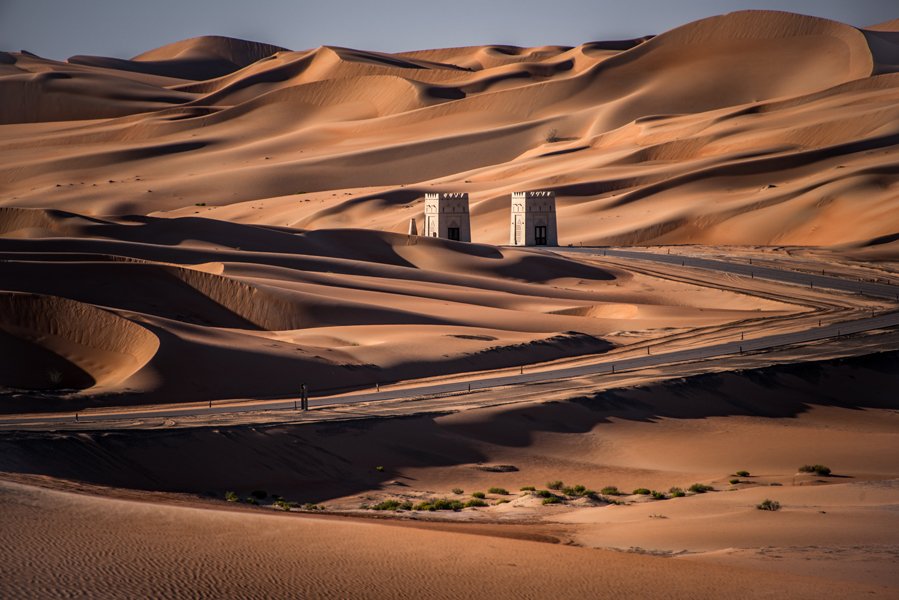Detour #99: The Empty Quarter, Oman
Gavin Green took a Range Rover on an ancient frankincense trail to the world’s largest sand sea in search of a lost city. A camel may well have been a better choice.
The great desert explorer Wilfred Thesiger wrote a number of fine books, and none better than Arabian Sands. It tells of his two journeys across the Arabian Peninsula’s Empty Quarter, the world’s largest sea of sand.
Thesiger journeyed across this dune-filled desert, bigger than France, in the late 1940s. He used camels, accompanied by a small band of Bedouin. Twenty years later, another great British explorer, Ranulph Fiennes, went to the Empty Quarter on a different quest. His mission was to discover the legendary lost city of Ubar, tagged by TE Lawrence (Lawrence of Arabia) as the ‘Atlantis of the Sands’.
Ubar, or so the legend goes, was a magical oasis somewhere in the sands of the southern Arabian Desert. It became important in about 2500 BC, when camels were first used to carry goods across the desert, and was destroyed – mysteriously – sometime between 300 and 500 AD. It thrived because it was a major trading post for frankincense, the richest commodity of ancient times. The gum from the stumpy frankincense tree was highly prized for its scent and was used for the finest perfume and incense. Celebrity customers included the Queen of Sheba, the King of Persia, Nero and, courtesy of the Three Wise Men, the baby Jesus.
The mountains just behind the coast of modern-day southern Oman produced the world’s finest frankincense. Great caravans of camels would head through Ubar on their northerly land route.
The world’s largest sea of sand
Inspired by Thesiger and Fiennes, in 2010 I set out to visit Empty Quarter and Ubar, which sits on its south-east fringe. My transport was a Range Rover TD-V8, and we used a local Bedouin guide.
From Salalah on the southern Oman coast, where Thesiger began his first crossing, we drove 30 miles along the coast to the finest frankincense-related archaeological site in Oman, Khor Rori, known in ancient times as Sumhuram. Here, ancient dhows laden with the precious gum sailed for Africa, Asia and Europe. Then we headed north and crossed the Qara mountains, the 3000ft high backdrop to Salalah.
After the mountains, the terrain is barren and arid. The tarmac road quickly gives way to a graded gravel track. We were on the old frankincense trail as we headed north in 42 deg heat. Little tufts of grass, acacias and tamarisks clung to life. We saw frankincense trees, ugly stubby little trees that, incongruously, often grow out of rocks. The track was badly corrugated and there were washouts, where infrequent flash floods had eroded the road.
The road cuts through the desert, but the desert is constantly fighting back
We headed for Shis’r, a small settlement on a hillock. Opposite on a small fenced-off site was the reason we’d come to Oman: the lost (now found) city of Ubar. It didn’t look much. There were decayed stone pillars and broken walls and helpful signs, in English and Arabic. It is built around a limestone cliff, at the bottom of which is a spring filled with sweet water.
There was a small dusty museum. It was closed. Said, our guide, went to a nearby grocery store to get the key. There was little to see apart from some photos and a few trinkets. The valuable finds had been dispatched to bigger museums.
Fiennes discovered the site in 1992, after a 20-year quest. (Although some experts still dispute that the Shis’r site is Ubar.) According to the archaeologist leading the dig, the reason for Ubar’s sudden destruction was the underground water: the limestone caverns collapsed and so did Ubar’s walls.
We headed to Al Hashman, the last town before the Empty Quarter. In the distance you could see mighty dunes. The sand became thicker under-tyre, the dunes bigger. A thinly disguised track wound around the dunes. The tracks became narrower and less defined; they were made, said Said, by Bedouin tour guides, their trusty camels now replaced by Land Cruisers, the new ships of the desert.
Massive sand dunes are a tough challenge for any off-roader
Guided by a mixture of Said and satnav, we climbed dunes but soon become bogged, the Range Rover’s tyres clawing hopelessly at the fine sand. The sun was now coming down, as we headed deeper into the desert, the light now a glorious poetic gold. We got stuck again and this time only the sand ladders could extract us.
We passed a vast mountain of sand. Said said it was the biggest dune in the area. I climbed it by foot and looked, with awe, at the scenery. The sand stretched for miles and miles, a massive range of orange, a sea of stormy golden waves, the sand patterns wonderfully and delicately symmetrical, formed by the wind. I saw nobody, no houses, no trees, just peaks and valleys of sand.
We went as far as possible, before Said said we must turn back. We’d already ventured much deeper into the desert than the Bedouin guides and their Land Cruisers. To go any further, only one form of transport would suffice. A camel.
Words Gavin Green Twitter
Photography Shutterstock
The most practical way to cross the Empty Quarter





